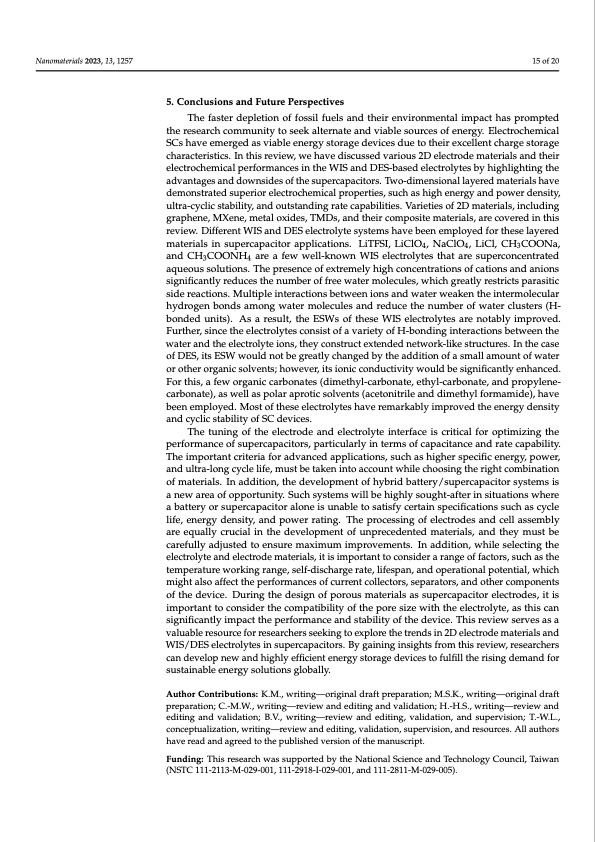PDF Publication Title:
Text from PDF Page: 015
Nanomaterials 2023, 13, 1257 15 of 20 5. Conclusions and Future Perspectives The faster depletion of fossil fuels and their environmental impact has prompted the research community to seek alternate and viable sources of energy. Electrochemical SCs have emerged as viable energy storage devices due to their excellent charge storage characteristics. In this review, we have discussed various 2D electrode materials and their electrochemical performances in the WIS and DES-based electrolytes by highlighting the advantages and downsides of the supercapacitors. Two-dimensional layered materials have demonstrated superior electrochemical properties, such as high energy and power density, ultra-cyclic stability, and outstanding rate capabilities. Varieties of 2D materials, including graphene, MXene, metal oxides, TMDs, and their composite materials, are covered in this review. Different WIS and DES electrolyte systems have been employed for these layered materials in supercapacitor applications. LiTFSI, LiClO4, NaClO4, LiCl, CH3COONa, and CH3COONH4 are a few well-known WIS electrolytes that are superconcentrated aqueous solutions. The presence of extremely high concentrations of cations and anions significantly reduces the number of free water molecules, which greatly restricts parasitic side reactions. Multiple interactions between ions and water weaken the intermolecular hydrogen bonds among water molecules and reduce the number of water clusters (H- bonded units). As a result, the ESWs of these WIS electrolytes are notably improved. Further, since the electrolytes consist of a variety of H-bonding interactions between the water and the electrolyte ions, they construct extended network-like structures. In the case of DES, its ESW would not be greatly changed by the addition of a small amount of water or other organic solvents; however, its ionic conductivity would be significantly enhanced. For this, a few organic carbonates (dimethyl-carbonate, ethyl-carbonate, and propylene- carbonate), as well as polar aprotic solvents (acetonitrile and dimethyl formamide), have been employed. Most of these electrolytes have remarkably improved the energy density and cyclic stability of SC devices. The tuning of the electrode and electrolyte interface is critical for optimizing the performance of supercapacitors, particularly in terms of capacitance and rate capability. The important criteria for advanced applications, such as higher specific energy, power, and ultra-long cycle life, must be taken into account while choosing the right combination of materials. In addition, the development of hybrid battery/supercapacitor systems is a new area of opportunity. Such systems will be highly sought-after in situations where a battery or supercapacitor alone is unable to satisfy certain specifications such as cycle life, energy density, and power rating. The processing of electrodes and cell assembly are equally crucial in the development of unprecedented materials, and they must be carefully adjusted to ensure maximum improvements. In addition, while selecting the electrolyte and electrode materials, it is important to consider a range of factors, such as the temperature working range, self-discharge rate, lifespan, and operational potential, which might also affect the performances of current collectors, separators, and other components of the device. During the design of porous materials as supercapacitor electrodes, it is important to consider the compatibility of the pore size with the electrolyte, as this can significantly impact the performance and stability of the device. This review serves as a valuable resource for researchers seeking to explore the trends in 2D electrode materials and WIS/DES electrolytes in supercapacitors. By gaining insights from this review, researchers can develop new and highly efficient energy storage devices to fulfill the rising demand for sustainable energy solutions globally. Author Contributions: K.M., writing—original draft preparation; M.S.K., writing—original draft preparation; C.-M.W., writing—review and editing and validation; H.-H.S., writing—review and editing and validation; B.V., writing—review and editing, validation, and supervision; T.-W.L., conceptualization, writing—review and editing, validation, supervision, and resources. All authors have read and agreed to the published version of the manuscript. Funding: This research was supported by the National Science and Technology Council, Taiwan (NSTC 111-2113-M-029-001, 111-2918-I-029-001, and 111-2811-M-029-005).PDF Image | Water-in-Salt Eutectic Solvent-Based Liquid Electrolytes

PDF Search Title:
Water-in-Salt Eutectic Solvent-Based Liquid ElectrolytesOriginal File Name Searched:
nanomaterials-13-01257.pdfDIY PDF Search: Google It | Yahoo | Bing
Salgenx Redox Flow Battery Technology: Power up your energy storage game with Salgenx Salt Water Battery. With its advanced technology, the flow battery provides reliable, scalable, and sustainable energy storage for utility-scale projects. Upgrade to a Salgenx flow battery today and take control of your energy future.
CONTACT TEL: 608-238-6001 Email: greg@infinityturbine.com (Standard Web Page)